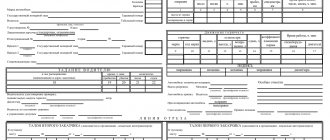Document role
The waybill solves several problems at once. This is due to the fact that it records all the important information regarding the operation of the car, including:
- its technical condition;
- mileage traveled;
- driver's working hours;
- completed moves during the shift;
- consumption of fuels and lubricants, etc.
Based on all this data, control is carried out over the use of the vehicle and the driver’s labor efficiency, and in the future, the accounting department of the enterprise calculates wages for the driver, mechanic and dispatcher.
The waybill is filled out for various vehicles: cars, trucks, and special equipment.
Who fills out the form
Maintaining waybills is usually the responsibility of the head of a structural unit, accountant, dispatcher or other employee (sometimes these documents are issued by the head of the organization himself).
ATTENTION! Drivers should not be allowed to fill out waybills.
The driver’s task to correctly prepare the waybill is only to sign an autograph about the acceptance and delivery of the car at the end of the work shift, as well as to make notes about the completed transfers.
The waybill is issued to the driver against signature, and the obligatory condition for its receipt is the submission of the document for the previous day.
In some cases, a waybill can be issued not for one work shift, but for a longer period (for example, for intercity transportation).
Requirements for a waybill
Waybill . The document most common in the process of primary accounting of cargo transportation. It is he, along with the Waybill (Bill of Lading), that determines the main performance indicators of the driver and the rolling stock as a whole, while the data indicated in the waybill is the basis for calculating the cost of cargo transportation and calculating payments to the driver for the work performed.
For trucks in our country, it is customary to use two unified forms of these documents approved back in November 1997.
- Form N 4-s. Used for cargo transportation, in which labor is paid on the basis of piece rates.
- Form N 4-p. Applicable to cargo transportation in the case where labor is paid at a temporary rate, designed to carry out cargo transportation for two customers during one working day or one driver’s work shift.
The customer is responsible for filling out the tear-off coupons of the waybill, and they will be the basis for issuing an invoice to him for the cargo transportation work performed by the organization that owns the car. A tear-off coupon is attached to such an invoice, on the basis of which the calculations were made. The waybill itself, as part of the reporting, remains with the organization that owns the car, and it duplicates records of the time during which the vehicle was busy performing work for a specific customer, and which will act as the basis for accounting for the work of a specific vehicle for a certain period of time.
In a situation where inventory items are subject to transportation, with time-based payment for work performed, the TTD numbers are recorded in the waybill, and a copy of the shipping document is attached as confirmation of the fact that the work has been completed. Based on the total number of tons of cargo transported, as well as on the basis of other indicators, the amount of work performed by the vehicle and the driver is determined.
Until the waybill is handed over to the driver, filling it out is the responsibility of the organization’s dispatcher or a person with similar authority. Other entries in the waybill are made by employees of the organization that is the owner of the vehicle and the customer (or customers). It is worth paying attention to the fact that the driver’s participation in the process of entering any data into the waybill is not allowed. The only exception is his signature, which certifies the acceptance of the vehicle upon leaving the territory and its delivery upon return.
Transfer of waybills to the driver using the specified forms is possible only upon certification by a signature of an authorized person. A waybill is issued for only one work shift. At the same time, a mandatory condition for issuing a new waybill is the submission of the last one for the previous period. When we talk about the previous period, we mean the previous closed working day or shift.
- 2 Requirements for filling out a waybill before leaving the garage
- 3 The procedure for filling out the waybill on the line.
- 4 The procedure for entering data into the waybill when returning the vehicle to the garage
- 5 Making marks on the waybill after it is handed over by the driver
- 6 Features of a truck waybill, form No. 4-p
The procedure for making entries in the travel form
The procedure for making entries in the forms of the sheets in question is clearly defined. It happens in the following sequence:
- Immediately below the name of the document, the date, month and year are recorded, which must correspond to the date of the corresponding registration entry about the issuance of this waybill in the journal.
- The corresponding code is entered into the line displaying the operating mode, on the basis of which the calculation and accrual of labor payments to the driver will be made.
- The lines “Column” and “Brigade” are intended for records of the corresponding divisions of the organization to which the car or driver is assigned.
- In the columns reflecting the vehicle data, indicate the make of the car with the obligatory designation of its state license plate, as well as the garage number.
- Personal and official information about the driver must be entered in the appropriate lines. They are the surname and initials of the employee, the personnel number assigned to the driver as an employee of the organization, the driver's license number, the class of the driver, whose work will be reflected in a specific waybill.
- In the column that requires the reflection of information about the license card, information about the type of license card (limited or standard) is entered, as well as its series and registration number.
- In the line “Trailers” the state license plate and garage number of the trailer or semi-trailer, the operation of which is expected, are indicated, indicating their brand. As for exchange trailers or semi-trailers, their data is entered into these columns directly at the places of their exchange.
- In the line “Accompanying persons” personal data (last name, initials) of persons whose duty is to accompany the vehicle during the work process are entered. This could be a loader, forwarder, trainee, etc.
- The section “Work of the driver and the vehicle” contains data on the time of transport leaving the territory and its return.
- In the “Assignment to the driver” section, an authorized person, usually a dispatcher, indicates information about the destination of the customer or department at whose disposal the driver is sent.
- The column “At whose disposal” presupposes the indication of the customer, whose order is subject to execution by the appropriate driver and vehicle.
- "Arrival time". It implies a clear recording (in hours and minutes) of the arrival of the declared vehicle at its destination for the execution of a one-time order. Or recording of arrival at the place of production, according to the work schedule of vehicles within the framework of the execution of a specific contract.
- Sections No. 20-21 provide information about where the cargo should be accepted and where the driver should deliver it in accordance with the requirements of a specific application or the terms of the contract. In other words, these columns are “Addresses of loading and unloading points.”
- Column 22 indicates the name of the cargo to be transported. Accordingly, the name of this column is “Name of the cargo”.
- The number of trips that will be required to complete the task determined by the application or one-time order is indicated in column No. 23 “Number of trips with cargo.”
- The length of the route within which cargo transportation will be carried out is determined from a city map or based on data from road authorities. The mileage is determined using a curvimeter or from a list of distances compiled taking into account these transportation certificates. Also, taking into account the distance can be based on the car’s speedometer readings during seasonal transportation, recorded in acts of the motor transport enterprise and the customer. These data are recorded in section No. 24 - “Distance”.
- The line “Transport tons” contains information about the amount of cargo requiring transportation to the customer.
As for any changes to the driver’s assignment, they can only be made by the motor transport organization that owns the vehicle. And only in exceptional cases, with prior agreement with the motor transport company, can this right be entrusted to the customer.
- The front side of the waybill contains the column “Issue fuel”. It is there that the amount of fuel required to fulfill the order is written down. The number of required liters of fuel is entered into the sheet in words, and takes into account the unspent balance of the previous day.
- In the corresponding column, the dispatcher’s signature records the accuracy of all data specified in the waybill, including the fact that the driver has a license.
Requirements for filling out a waybill before leaving the garage
The sequence of entering data until the vehicle leaves the garage is also determined.
- In the section “Movement of Fuel” (columns No. 9, 10 and 11) and in the corresponding lines, the fuel and lubricants technician, tanker or other authorized person enters data on the amount of fuel dispensed.
- There must be a medical examination mark on the front side of the travel document. This mark can only be affixed by the person directly performing the pre-trip medical examination, the purpose of which is to assess the driver’s health status, as well as the possibility of the latter being allowed to drive a vehicle.
- Before the car leaves the garage for the line, the mechanic of the checkpoint (checkpoint) or the technical control department (technical control department) takes the current speedometer readings and enters them in the “Speedometer readings” column of the “Driver and vehicle work” section.
- These same ATP workers record the current departure time of the vehicle and display this data in column No. 6 of the waybill - “Actual time” - using a stamp clock. In case of their absence or malfunction, the time is entered manually. The sequence of data display is as follows: day, month, hours, minutes.
- “Balance upon departure” (column No. 12 of the section “Fuel movement”) is also filled in by the gearbox mechanic or quality control department. Here the actual remaining fuel in the vehicle’s tanks upon departure is displayed, and a signature certifies the accuracy of the information provided.
- In the lines intended to display information regarding the technical condition of the car, a number of facts are displayed by means of a signature by the quality control or transmission mechanic. This is both the fact of delivery to the driver of a vehicle in a specific technical condition, and permission to leave the garage. The driver certifies this information, as well as the fact of receipt of the car and the task to perform the work, with a personal signature.
The procedure for filling out a waybill on the line.
There are also a number of requirements for the process of entering data into the waybill for a truck on the line.
- The procedure for filling out the section “Sequence of task completion” for form No. 4-c.
- Column No. 27 sequentially displays the numbers of trips made. The need for this action is due to the subsequent posting of the attached waybills according to the completed flights.
- Columns No. 36-38 (“Numbers of the attached shipping documents (TTD)”) are intended for the shipper to display all TTD numbers related to a specific trip.
- The date and time of presentation of the waybill to the consignee or consignor is taken at the entrance gate or at the checkpoint at the loading and unloading points and is displayed in columns No. 28-30. If there is no checkpoint or entry gate, then these columns are not filled in, and the time of arrival at the unloading or loading point is displayed in the corresponding section of the TTN.
- The name of the shipper is entered in columns No. 39-40. The reliability of the information and details specified in the waybill is confirmed by the signature and seal of the shipper.
- If circumstances arise that cause transport downtime, the section “Downtime on the line” is filled in. The information is entered into the appropriate columns by a technical assistance service employee or a person with such authority. They write down the reasons, date, and length of downtime. The reliability of the specified data is confirmed by the signatures of these persons.
- The “Special Notes” section located on the front side must be filled out if the recording requires information that is not provided for in the waybill form. These can be marks from the traffic police, various road services, a mark indicating the customer’s refusal to load the car, etc.
The procedure for entering data into the waybill when returning the vehicle to the garage
Upon returning the car to the garage, the following procedure for entering data into the car’s waybill is adopted:
1. In the “Results of the vehicle and trailers” section, data is displayed on fuel consumption, time spent on duty, the number of trips and races, kilometers traveled during operation, as well as the volume of transportation carried out.
2. The quality control or checkpoint mechanic fills in the “Balance upon return” column, located in the “Fuel Movement” section. Here, the fuel and lubricants technician, or another person with the appropriate authority, confirms that the driver has delivered the fuel.
3. After the driver has handed over the vehicle to the quality control or checkpoint mechanic in a certain technical condition (good or bad), he is given an o. In turn, the quality control or transmission mechanic, with his signature, endorses acceptance from the driver of a car in a particular technical condition.
Making notes on the waybill after it is handed over by the driver
The responsible employee of the dispatch service, or another specialist of the enterprise vested with such powers, fills out the waybill according to certain rules. 1. In the section “Work of the driver and the vehicle”, according to the existing table of distances, the dispatcher enters information in the column “Zero mileage”. Here they record the mileage traveled by the vehicle from the garage to the first loading point, as well as from the last unloading point back to the garage.
2. The section “Fuel Movement” contains several columns that require filling out.
So, in the column “Coefficient of change in the norm”, the dispatcher enters indicators that display one general coefficient of change in the norm of fuel consumption. This coefficient is applied for the entire day of vehicle operation and is associated with the operation of vehicles in accordance with increased fuel consumption standards.
Columns No. 16 (“Operating time of special equipment”) and No. 17 (“Engine operating time”) require entering data supported by the corresponding entries in the TTL attached to the waybill. These records, as a rule, contain information about the operating time of special equipment, as well as additional operating time of the engine under special operating conditions. This could be, for example, forced engine operation during loading and unloading operations. The need to display this information is necessary to calculate additional fuel consumption rates. The correctness of entering this information is confirmed by the dispatcher’s signature.
3. The next step is to fill out the “Task Sequence” section. Here the dispatcher displays the total number of trips. The entry is made in column No. 27, cell “Total”. And in the line “TCD in quantity” the total number of shipping documents handed over by the driver is displayed. The driver, to confirm the accuracy of the data on the number of submitted and accepted technical specifications, puts his signature in the column “Passed by the driver.” The dispatcher confirms this fact with his signature in the line “Accepted by the dispatcher.”
Features of a truck waybill form No. 4-p
There are a number of features of entering information into the waybill form 4-p. They are as follows:
- The section “Assignment to the driver” is filled out by the dispatcher, according to the application or one-time order of the client, and requires filling out the following columns:
- Column No. 18 “At whose disposal.” Data about the customer should be displayed here, namely, his name and address for performing the work;
— columns No. 19, 20. Their data contains information about the planned time of arrival and departure of the vehicle from the task;
— column No. 21 — the estimated number of hours allocated for the work;
— Column No. 22 – estimated number of trips.
- Tear-off coupon. Its completion is the responsibility of the customer. A tear-off coupon is the basis for the motor transport company to issue an invoice to the customer for services rendered.
The procedure for filling out the tear-off coupon is as follows:
- according to the information contained in the waybill presented by the driver, the customer enters the date of issue and the number of the waybill in the appropriate sections and columns; the name of the ATP whose vehicles carry out cargo transportation, and also indicates the brands and state numbers of the arriving vehicles;
— in the line “Customer” enters the name of the organization, full name. persons who, by virtue of their official duties, are responsible for the use of the vehicle;
— indicates the actual time of arrival and departure of vehicles in the appropriate lines;
— fills in the lines “Attached TTD”, in which he writes the numbers and quantity of transport documents, one copy of which must be attached to the waybill;
— in the corresponding line indicates the number of flights made;
- certifies the accuracy of the data indicated in the relevant lines with his signature and seal.
It is worth noting that all responsibility for the correct execution of vehicle waybills rests directly with the heads of the organization and officials whose responsibilities include monitoring the operation of freight transport, as well as persons taking part in filling out the document.
The storage of waybills, according to existing regulations, must be carried out together with the technical documentation, which allows for their simultaneous verification.
- Author: Anastasia
Rate this article:
- 5
- 4
- 3
- 2
- 1
(2 votes, average: 5 out of 5)
Share with your friends!
Documentation of cargo transportation
Documents presented when transporting goods
Features of the document
Unified standards for primary documents have been abolished since 2013, so now employees of enterprises have the right to choose whether to issue a waybill each time in a free form (which is impractical), develop their own unique document form, or use a unified, previously mandatory form. The last option turns out to be the most preferable for many companies, because such a form includes all the necessary details and lines (i.e. there is no need to spend time developing and creating the structure and content of the sheet).
The document is kept in paper (printed) form, information is entered into it with a ballpoint pen of any dark color (other writing tools - felt-tip pens, pencils, etc. should not be used).
When filling out the waybill, you should avoid blots and mistakes. If any mistake does occur, it is better to fill out a new form, but if this is not possible, you need to correct the incorrect data very carefully. You can either cover them up with a corrector, or cross them out and write the correct information on top (by making an o next to them). All edits must be certified by the signature of the person who made them.
After issuing a waybill, the form must be signed by the responsible persons and also certified by the seal of the company (provided that the use of stamps for endorsement of such papers is enshrined in the company’s accounting policy).
Before moving on to the example of filling out a document, let’s say a few words about the procedure for entering information into it.
The form is filled out by the responsible person before the car leaves the garage.
The sheet is signed by: a mechanic who monitors the technical condition of the vehicle, if necessary, a medical worker who certifies the physical condition of the driver, the driver himself and the responsible employee.
Sample of filling out a waybill
So, the following are written in order on the sheet:
- date of its preparation;
- name of the organization and its address;
- OKPO code;
- car make (if the car is foreign-made, the model can be entered in Russian transcription);
- state number and garage number (if available);
- information about the driver: his full name, personnel number, driver's license number, driving class. Information about the license card must be entered if the driver operates using a license.
The second part of the form on the left includes information about the task issued to the driver for the current shift. Here are the following:
- who exactly issued the order: structural unit and name of the enterprise;
- delivery address;
- time of leaving the garage (exactly - in hours and minutes);
- signatures of the mechanic and driver.
After the trip, you should note the time of return to the garage, periods of waiting, downtime, destination of trips, etc., and also confirm all this information with the autograph of the driver.
On the right side of the document the following is indicated:
- first, data on the technical condition of the car at the time of departure: speedometer readings certifying the serviceability of the car, signatures of the mechanic and driver, brand and code of the fuel used;
- then, after returning, the fuel consumption is described in detail (the tanker or fuel technician enters the data here): how much was issued according to the refueling sheet (in liters), how much was in the tank when leaving the garage and when arriving back, consumption (standardized and actual), and also information about savings or overspending;
- then the numbers from the speedometer are entered, and the mechanic certifies all this again with his signature.
On the reverse side of the waybill, information about trips made during the work shift is indicated (in order). Here it is written
- the address from which the car left,
- destination,
- departure and return times,
- mileage traveled,
- driver's signature.
Finally, the form is filled out by an accounting employee who calculates the number of hours actually worked, the kilometers traveled, and, based on this, calculates the driver’s wages.
Where can I get a travel document form?
Use ready-made forms from Goskomstat or develop your own.
How to develop your own travel forms
- Include the required details in the form: name and document number, validity period, vehicle owner, transport information, driver information, fuel information, odometer readings and route.
- Add details that will help you control drivers or calculate salaries.
- Approve the form with an order. If you are an LLC, record it in your accounting policy.
Submit reports in three clicks
Elba will calculate taxes and prepare business reports based on the simplified tax system, UTII and patent. It will also help you create invoices, acts and invoices.
Try 30 days free Gift for new entrepreneurs A year on “Premium” for individual entrepreneurs under 3 months









